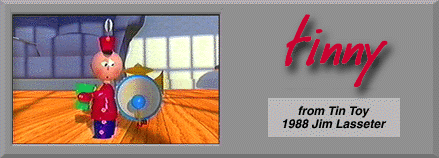

Tin Toy is a pretty incredible animation, and it is easy to see exactly what merited the Academy Award that it received. It was created by John Lasseter and others at Pixar, using their standard combination of keyframe animation and classical techniques of animation.
It portrays Tinny (the Tin Toy) and his first day on the job as a baby's plaything. Tinny is at first anxious to be a fun toy, but when he discovers the destructive nature of young humans, he begins to think otherwise.
Most likely Tin Toy will be the first place you have seen a computer-animated human. Surveying most of the computer animations that exist will find that any slightly "humanesque" forms consist of a sphere for a head, and a body made of several cylinders. And though the baby does seem a bit crude at times, it's quite amazing to realize that all its claps, crawls, and drools are all computer-generated.

If you look only at the baby's face, you are sure to comment that it doesn't look exactly like a baby. It's a bit rough at some points; in some places it doesn't look like soft baby-fat. But pay attention to the animation! This moves like a baby. It shoves anything in its mouth, like a baby. It claps with glee at a new object to destroy, like a baby. And of course, it's far more interested in the Pixar shopping bag than Tinny, like a baby.
The bag and the cellophane of the Tin Toy box are both great. They are very realistic elements. Of course, you'll probably be laughing too much during the in-the-box scene to concentrate on them; the warping of Billy is accurate, but more importantly, very humorous.

Oh, and don't forget to check out that feather! The code that controls the dynamics of the feather in tinny's cap was written by local talent David Salesin.
 Credits : Tin Toy
Credits : Tin Toy